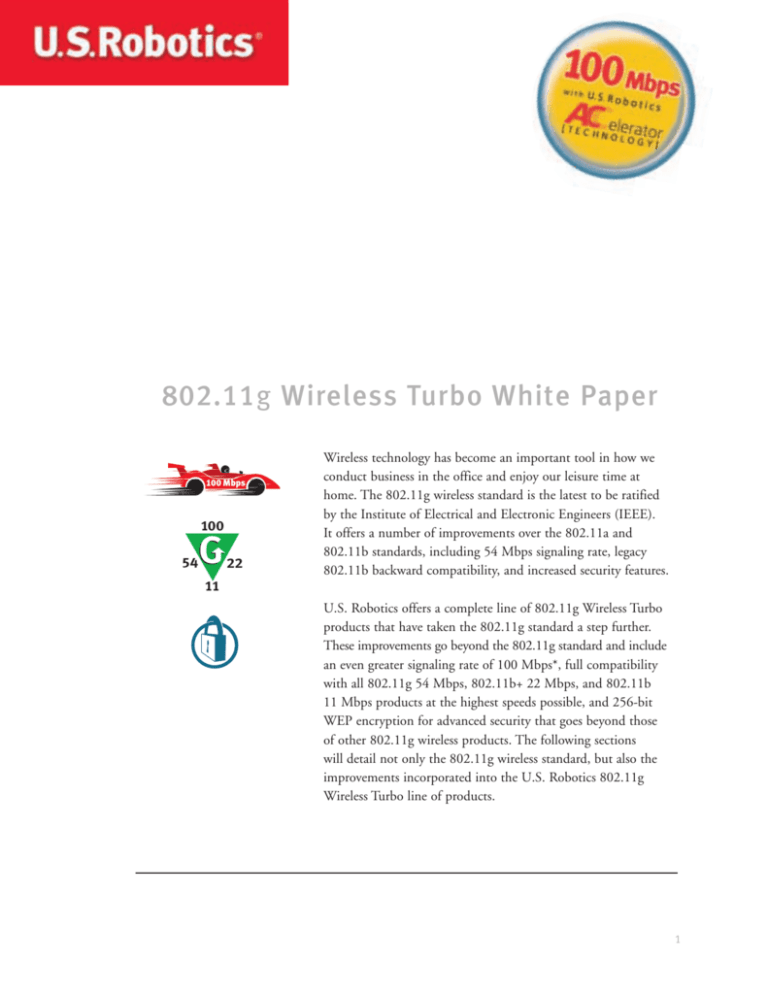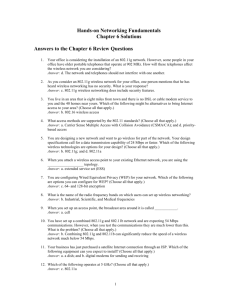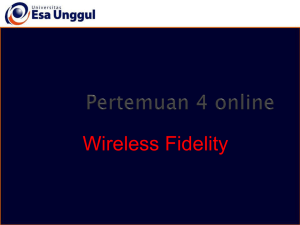
802.11g Wireless Turbo White Paper
100 Mbps
100
54
22
Wireless technology has become an important tool in how we
conduct business in the office and enjoy our leisure time at
home. The 802.11g wireless standard is the latest to be ratified
by the Institute of Electrical and Electronic Engineers (IEEE).
It offers a number of improvements over the 802.11a and
802.11b standards, including 54 Mbps signaling rate, legacy
802.11b backward compatibility, and increased security features.
11
U.S. Robotics offers a complete line of 802.11g Wireless Turbo
products that have taken the 802.11g standard a step further.
These improvements go beyond the 802.11g standard and include
an even greater signaling rate of 100 Mbps*, full compatibility
with all 802.11g 54 Mbps, 802.11b+ 22 Mbps, and 802.11b
11 Mbps products at the highest speeds possible, and 256-bit
WEP encryption for advanced security that goes beyond those
of other 802.11g wireless products. The following sections
will detail not only the 802.11g wireless standard, but also the
improvements incorporated into the U.S. Robotics 802.11g
Wireless Turbo line of products.
1
Data Throughput and Signaling Rate
In order to understand the true capabilities
and efficiencies (as well as inefficiencies) of any
network, wired or wireless, a distinction must
first be made between two commonly misunderstood networking terms: data throughput
and signaling rate. Data throughput is the actual
“amount” of data transmitted and received by
a wireless product, while the signaling rate, or
data rate, represents a theoretical maximum. So,
while wireless networking gear is often classified
according to its standards-based signaling rate,
such as 54 Mbps for 802.11g, the actual data
throughput, or data being transmitted, is
often just a fraction of the signaling rate’s
theoretical maximum.
Data throughput can be limited due to a
number of important environmental and
product-specific factors, including:
• Distance between Wireless Local Area
Network (WLAN) devices: access points
(APs) and network interface cards (NICs)
• Transmission power levels
• Building and home materials
• Radio frequency interference
• Signal propagation
• Antenna type and location
So, even though the new 802.11g wireless
networking products available are capable of a
54 Mbps signaling rate, the practical, or“actual,”
data throughput rate is more likely to be in
the 10 – 12 Mbps range. That is, except when
using U.S. Robotics 802.11g Wireless Turbo
networking products.
The new U.S. Robotics 802.11g Wireless
Turbo portfolio of products with 100 Mbps
2
Accelerator Technology is actually capable of
delivering a signaling rate comparable to a
100 Mbps* wireless networking product, with
all data transmission taking place on a single
channel, leaving other channels open for a variety
of other wireless devices. This translates to actual
data throughput of 20 Mbps – nearly double that
of other 802.11g products. This is due to the
inclusion of exclusive U.S. Robotics 100 Mbps
Accelerator Technology, and the key to this technology is Packet Binary Convolutional Coding.
Note that data throughput rates as stated herein (10-12 Mbps for 802.11g
industry standard vs. 20 Mbps for U.S. Robotics 802.11g Wireless Turbo
Products with Accelerator Technology) are based on practical, “real world”
model office environments. Throughput rates can test substantially higher
in a pristine environment (e.g., no walls, no computer interference, etc.)
when using sophisticated testing equipment.
Packet Binary Convolutional Coding
Packet Binary Convolutional Coding (PBCC),
sometimes known as 802.11b+, is a modulation/
coding technique that was first developed for use
in 802.11b networks as a means of doubling the
signaling rate of the 11 Mbps standard to 22 Mbps
while maintaining backward compatibility with
legacy 802.11b 11 Mbps wireless equipment.
U.S. Robotics first made full use of this advance
in wireless technology by incorporating PBCC
into its portfolio of 22 Mbps wireless networking
products, resulting in a signaling rate of 54 Mbps
and comparable in data throughput to 802.11g
wireless standardproducts. Though PBCC was not
included in the final 802.11g 54 Mbps standard, it
was included as an optional modulation technique
and has since been incorporated into the
U.S. Robotics 802.11g Wireless Turbo portfolio.
In its simplest form, PBCC works by reducing
overhead (bandwidth used to transmit non-data)
through the removal of extraneous information
and optimizing transmission by using smaller
data packets, cutting the response time in
processing those packets, and thus, allowing
for a greater amount of data to be transmitted
between networked devices. Specific examples
of overhead include:
• Protocol headers – carry information for
controlling the device
• Frame interval times – allow users to gain
access to the frequency band
• Error and flow control – ensure the integrity
of the wireless transmission
• Received message acknowledgements –
verify that messages were received correctly
or need to be resent due to errors and/or
message collisions
Some wireless networking products utilize
“channel bonding,” a method that combines
two wireless data channels to effectively double
data transfer speeds. One channel is reserved for
transmitting data only, while the other channel
is reserved for receiving data only. However,
because two channels are used in the process,
fewer channels remain available for other
devices, reducing overall network capacity.
802.11g Wireless Turbo White Paper
U.S. Robotics 100 Mbps Accelerator Technology,
utilizing PBCC, uses only a single channel for
data transmission to maximize capacity. Because
PBCC uses the same type of protocol header as
legacy 802.11b wireless devices, U.S. Robotics
802.11g Wireless Turbo products are fully
compatible with all 802.11g 54 Mbps, 802.11b+
22 Mbps, and 802.11b 11 Mbps standard
products while delivering the best data throughput
rates possible.
Compatibility
No small part of proper network design involves
ensuring that clients and devices can access
network data, send/retrieve e-mail, surf the Web,
and perform other tasks with maximum efficiency.
Network design becomes a much more complex
issue when interconnecting both LANs and
WLANs into a single seamless network. A major
hurdle to overcome in WLANs is ensuring that
each wireless device on the network achieves its
optimal data throughput.
3
Until recently, the only way to ensure that each
wireless networking device was achieving its
optimal data throughput was to use wireless
networking gear from only a single manufacturer
utilizing a single wireless networking standard;
e.g., 802.11a 54 Mbps, 802.11b 11 Mbps, or
802.11g 54 Mbps. This meant that users were
“locked” into a single brand and technology
standard, making network upgrades complicated
and impractical. However, trying to maintain a
WLAN that uses only gear from a specific manufacturer utilizing only a single wireless networking
standard is also impractical and does not allow for
upgrades to the latest high-speed technologies.
WLANs have become commonplace and wireless
“hotspots” exist in airports, restaurants, and
even in casual cafés. For example, many upscale
cafés now offer WLAN services to their patrons.
Assume the café is outfitted with an 802.11g
54 Mbps wireless standard access point (AP).
The 802.11g standard is designed so that it can
be used in a mixed mode environment and for
backward compatibility with 802.11b 11 Mbps
wireless products. So, for those users setting up
their laptops utilizing 802.11b 11 Mbps wireless
PC cards, the café’s AP will be compatible.
However, this kind of compatibility will come
at the cost of wireless speed optimization. The
AP, upon sensing the 802.11b 11 Mbps PC
card, will, in an effort to maintain a consistent
speed throughout the WLAN, cause a network
slowdown and will fall back to a data rate of
11 Mbps, irrespective to the other devices on
the WLAN. This kind of network slowdown
is caused by mixing different wireless products
that utilize different wireless standards, also
known as a mixed mode environment, and is
4
a limiting factor for virtually any wireless network,
from the smallest café to the largest enterprise
office. And in a realistic working scenario, it is
difficult to imagine any wireless network that
utilizes a single manufacturer’s gear utilizing a
single wireless standard – it just isn’t practical.
For the new U.S. Robotics 802.11g Wireless
Turbo family of wireless networking products,
such network slowdowns aren’t a point of concern.
In fact, U.S. Robotics 802.11g Wireless Turbo
products eliminate network slowdown altogether
and ensure that each wireless device on the
network connects independently at that device’s
fastest speed possible. The same things can’t
be said for other competitive wireless products.
Only U.S. Robotics offers full 802.11g 54 Mbps,
802.11b+ 22 Mbps, and 802.11b 11 Mbps
wireless product compatibility. So, whether a
wireless client is using the latest 802.11g gear,
or a combination of 802.11g and 802.11b in a
mixed mode environment, U.S. Robotics wireless
networking solutions will continue to ensure
maximum wireless network efficiency and
security in any wireless network.
Security
Security is an obvious concern with any network:
wired or wireless. Because communication over
a traditional wired network is, by its very nature,
over physical wires, security is often built into
the physical infrastructure. WLANs operate
over radio signals, so the same security measures
will not necessarily apply. For business and
enterprise users, as well as many home users,
network and data security is of the utmost
concern. To address this, there are a number
of security features that a WLAN user can use
to limit a network to hacker attacks, vandalism,
and corporate espionage, including:
• Wired Equivalent Privacy (WEP)
• Disable Broadcast SSID
• Wi-Fi Protected Access (WPA)
• MAC address authentication
• 802.1x network authentication
Wired Equivalent Privacy (WEP)
Wired Equivalent Privacy (WEP) uses 64- and
128-bit encryption and is the cipher scheme
designated for use in 802.11a, 802.11b, and
802.11g networking. U.S. Robotics 802.11g
Wireless Turbo products include enhanced
256-bit WEP encryption that is not commonly
available in the 802.11b and 802.11g standards
for security up to 10 times greater than standard
wireless networks. WEP encrypts the data
transmitted over a WLAN, protecting the once
vulnerable communication between the client and
access point. When combined with traditional
security measures (password protection, authentication, encryption, virtual private networks),
WEP can be very effective.
Disable Broadcast SSID
A Service Set Identifier (SSID) is a uniquely
assigned alphanumeric designator/name (from
1 – 32 bytes) that is used to identify a WLAN,
ensuring that wireless devices will connect to
the proper WLAN when multiple WLANs are
operating in close, overlapping proximity. A
base station will essentially broadcast its presence,
which is then picked up by client PCs (both
authorized and unauthorized).
Newly purchased wireless networking gear will
come with a default SSID assigned. Default
SSIDs should be changed immediately to avoid
network hacking. The U.S. Robotics 802.11g
802.11g Wireless Turbo White Paper
Wireless Turbo Router (model 8054) and
802.11g Wireless Turbo Multi-Function Access
Point (model 5450) both come with Disable
Broadcast SSID which, when turned on, allow
only those base stations and clients with matching
SSIDs to associate with one another, blocking out
unauthorized users that lack the correct SSID.
Wi-Fi Protected Access (WPA)
Wi-Fi Protected Access (WPA) extends the
functionality of WEP by using 802.1x network
authentication and Temporal Key Integrity
Protocol (TKIP) encryption measures. What
802.1x network authentication does, depending
on whether the application is in “enterprise
mode” (for businesses) or “home mode” (for
home users), upon user authentication, is to
either create a unique “pair-wise” key, or master
key, for the client’s computing session running
in enterprise mode; or for home mode sessions,
the user simply enters a password, or master key,
onto each AP and PC on the wireless network.
The pair-wise key is then distributed to the
client and AP where unique encryption keys
are dynamically generated to encrypt the data
packets being transmitted during that particular
computing session.
Upon successful authentication, TKIP then
alters the single static 40-bit WEP security key
into multiple dynamic 128-bit security keys,
strengthening the basic framework of WEP
into a much more complex, secure form of
encryption. In essence, TKIP replaces the single
repeatedly used WEP key with approximately
500 trillion other possible keys that could
potentially be used for each data packet and
that will never be used more than once.
5
MAC address authentication
Some access points allow users to specify exactly
which Media Access Control (MAC) addresses
can communicate with the network. A MAC
address is a hardware address that uniquely
identifies each node of a network. Every
network adapter in the world has a unique
MAC address. By strictly specifying only those
MAC addresses that can attach to a network,
unauthorized users can be denied. MAC address
authentication does just that. The network’s
base station (access point) maintains a database
of authorized MAC addresses. Only those
devices with authorized MAC addresses are
allowed onto the network. The U.S. Robotics
802.11g Wireless Turbo Router (model 8054)
and 802.11g Wireless Turbo Multi-Function
Access Point (model 5450) both come with
built-in MAC address authentication.
802.1x network authentication
802.1x is an authentication method that forces
an individual client (laptop or desktop PC)
attempting to log on to a WLAN access point
(AP) into an unauthorized state, whereby the
client sends the AP an Extensible Authentication
Protocol (EAP) start message. The AP responds
by sending an EAP requesting the identity of
the client. The client, in turn, acknowledges by
sending its identity to the AP, which, it then
forwards to an authentication server. Using an
algorithm, the authentication server checks the
identity of the client and responds to the AP
with either an accept or reject message. If the
client is accepted, the AP will change the client’s
previously forced unauthorized state into an
authorized state and grant network access.
802.1x network authentication is part of the
802.11g wireless standard and included in all
802.11g compliant wireless standard products,
6
including the entire U.S. Robotics 802.11g
Wireless Turbo line.
U.S. Robotics 802.11g Wireless
Turbo Portfolio
U.S. Robotics offers a total 802.11g Wireless
Turbo high-speed wireless networking solution
that incorporates our exclusive 100 Mbps
Accelerator Technology to provide the performance
and data throughput rates equivalent to
100 Mbps* but with the unsurpassed security features, reliability, and greater product compatibility
only available from U.S. Robotics.
802.11g Wireless Turbo Router – Model 8054
The 802.11g Wireless Turbo Router is ideal
for sharing high-speed Internet access among
multiple computers.
• 4 products in 1: 802.11g Wireless Turbo
Access Point, 4-Port Ethernet Switch,
Router, and Firewall
• Includes built-in MAC address authentication
• Removable antennas easily detach for
upgrading or replacement
802.11g Wireless Turbo Multi-Function
Access Point – Model 5450
The 802.11g Wireless Turbo Multi-Function
Access Point is a professional-grade access point
that has the power and features to make a wireless
network out of an existing wired network and
wirelessly extend the reach of the Internet
throughout your home or office.
• 5 products in 1: Access Point, Bridge, MultiBridge, Client, and Repeater
• Allows full Simple Network Management
Protocol (SNMP) management for network
administration
• Removable antennas easily detach for
upgrading or replacement
802.11g Wireless Turbo PCI Adapter –
Model 5416
The 802.11g Wireless Turbo PCI Adapter lets
users wirelessly connect to the power on an
entire network from their desktop computer.
Connect your existing wired network to the
wireless world and start accessing the Internet
from almost anywhere*.
• For use in desktop computers
• Included Site Survey feature makes finding
the closest access point easy and simplifies
wireless network configuration
• Removable antenna easily detaches for
upgrading or replacement
802.11g Wireless Turbo PC Card –
Model 5410
The 802.11g Wireless Turbo PC Card lets
you take the power of an entire network with
you – on your laptop computer. Stay connected
to e-mail, shared files, and the Internet from
wherever you need it*.
• For use in laptop computers
• Included Site Survey feature makes finding
the closest access point easy and simplifies
wireless network configuration
• Unique low-power design gets the most from
a laptop’s battery to keep users online longer
Wireless Turbo USB Adapter – Model 2220
The Wireless Turbo USB Adapter instantly
turns your desktop or laptop PCs into a secure
wireless network.
• For use with any computer’s USB 1.1 port
• Ideal for instant laptop or desktop wireless
networking
• Compact design – fits in your pocket
U.S. Robotics wireless networking solutions are
built upon proven technology and backed by an
organization that is committed to the highest
standards of product quality and customer
satisfaction. So whether you’re starting off small,
growing your network, or trying to communicate
among multiple networks, U.S. Robotics has
a solution that will fit your particular needs.
U.S. Robotics continues to develop solutions to
provide data access to both business professionals
and home users, and the wireless networking
solutions represented here are just some of our
latest developments in keeping people connected
worldwide – with information, entertainment,
and each other.
* Capable of data throughput rates equivalent to 100 Mbps performance. Actual performance may vary depending on operating environment and distance between networked computers.
Copyright © 2003 U.S. Robotics Corporation. All rights reserved. U.S. Robotics and the U.S. Robotics logo are registered trademarks of U.S. Robotics Corporation.
Other product names are for identification purposes only and may be trademarks of their respective companies. Product specifications subject to change without notice.
802.11g Wireless Turbo White Paper
7
www.usr.com








